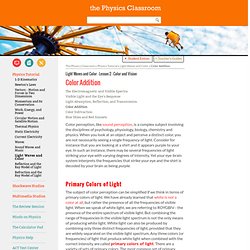

Index. Introduction. Revising physics revision. Cyberphysics, the revision website. Physics Lessons, Tutorials and Physics Help. Color Box Applet. Color Addition. Color perception, like sound perception, is a complex subject involving the disciplines of psychology, physiology, biology, chemistry and physics.

When you look at an object and perceive a distinct color, you are not necessarily seeing a single frequency of light. Consider for instance that you are looking at a shirt and it appears purple to your eye. In such an instance, there may be several frequencies of light striking your eye with varying degrees of intensity. Yet your eye-brain system interprets the frequencies that strike your eye and the shirt is decoded by your brain as being purple. Primary Colors of Light The subject of color perception can be simplified if we think in terms of primary colors of light. In fact, the mixing together (or addition) of two or three of these three primary colors of light with varying degrees of intensity can produce a wide range of other colors.
The addition of the primary colors of light can be demonstrated using a light box. Color Addition Rules. Y = mx + c. Any function: y = f(x) that graphs as a straight line has an equation of this form: NOTE: This does not include vertical lines, because they are not functions of 'x': y = f(x).

A function of 'x' cannot have more than one point in the same vertical line. 'Gradient' is a number that represents the steepness of a straight line. A horizontal line has gradient zero. A 45º line has gradient 1, and a vertical line has infinite gradient. The sign of the gradient is important. Gradient is an exact quantity. 1. 2. The change in 'x' = x - x1 while the change in 'y' = y - y1. Free support for Physics for You. GHS Advancing Physics: Links. GHS Advancing Physics: Help for students. Physics. Physics Powerpoint Presentations - Free download. PHY 311 Teaching High School Physics. Realizing the Democratic Ideal: Teacher Education at Illinois State University Fall Semester 2013 last updated 8/8/2013 Catalog Description: 18 hrs in PHY, C or better in TCH 216, or conc reg req.

Note Well: We have been notified that effective January 2010, anyone who wants to complete any clinical experiences in schools must have passed a Criminal Background Check prior to starting. We have been notified by the Illinois State Board of Education that individuals who will be applying for their initial teaching certification or additional endorsements as of 2/1/2012 must have a grade of "C" or above in all required coursework that is part of their program. Instructor: Meeting Days/Times/Location: During fall semester 2012, the class will meet on Mondays and Wednesdays from 4:00 p.m. to 5:15 p.m. starting August 19th in Moulton Hall, room 307B. Methodology: This course is designed to bridge the gap between educational theory and practice.
Performance Objectives for All Undergraduates: Grading: